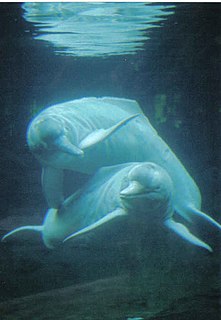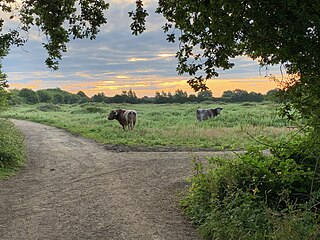
The hippopotamus, also called the hippo, common hippopotamus, or river hippopotamus, is a large semiaquatic mammal and ungulate which is mostly herbivorous and native to sub-Saharan Africa. It is one of only two extant species in the family Hippopotamidae, the other being the pygmy hippopotamus. Its name comes from the ancient Greek for "river horse" (ἱπποπόταμος).

Pablo Emilio Escobar Gaviria was a Colombian drug lord and narcoterrorist who was the founder and sole leader of the Medellín Cartel. Dubbed "the king of cocaine", Escobar is the wealthiest criminal in history, having amassed an estimated net worth of US$30 billion by the time of his death—equivalent to $64 billion as of 2021—while his drug cartel monopolized the cocaine trade into the United States in the 1980s and early 1990s.
The Medellín Cartel was a powerful and highly organized Colombian drug cartel and terrorist-type criminal organization originating in the city of Medellín, Colombia that was founded and led by Pablo Escobar. It is often considered the first major “drug cartel” and was referred to as such due to the organization's upper echelons being built on a partnership between multiple Colombian traffickers operating alongside Escobar. Included were Jorge Luis Ochoa Vásquez, Juan David Ochoa Vásquez, José Gonzalo Rodríguez Gacha and Carlos Lehder. The cartel operated from 1972 to 1993 in Bolivia, Colombia, Panama, Central America, Peru, the Bahamas, the United States, as well as in Canada. Although the organization started out as a smuggling network in the early 1970s, it wasn't until 1976 that the organization turned to trafficking cocaine. This was a result of Escobar getting introduced to the lucrative idea of cocaine smuggling by fellow Colombian trafficker Griselda Blanco. At the height of its operations, the Medellín Cartel smuggled multiple tons of cocaine each week into countries around the world and brought in up to US$60 million daily in drug profits.

The mata mata, mata-mata, or matamata is a freshwater turtle species found in South America, primarily in the Amazon and Orinoco basins. It is one of two extant species in the genus Chelus, the other being Chelus orinocensis.

The Magdalena River is the main river of Colombia, flowing northward about 1,528 kilometres (949 mi) through the western half of the country. It takes its name from the biblical figure Mary Magdalene. It is navigable through much of its lower reaches, in spite of the shifting sand bars at the mouth of its delta, as far as Honda, at the downstream base of its rapids. It flows through the Magdalena River Valley.

The Bolson tortoise, also called the Mexican giant tortoise or yellow-margined tortoise, is a species of tortoise from North America. Of the six North American tortoise species, it is the largest, having a carapace length of about 46 cm (18 in). It lives in a region of the Chihuahuan Desert known as the Bolsón de Mapimí, which is located in north-central Mexico.

Chelodina, collectively known as snake-necked turtles, is a large and diverse genus of long-necked chelid turtles with a complicated nomenclatural history. Although in the past, Macrochelodina and Macrodiremys have been considered separate genera and prior to that all the same, they are now considered subgenera of the Chelodina, further Macrochelodina and Macrodiremys are now known to apply to the same species, hence Chelydera is used for the northern snake-necked turtles.
Hacienda Nápoles was the luxurious estate built and owned by Colombian drug lord Pablo Escobar in Puerto Triunfo, Antioquia Department, Colombia, approximately 150 km (93 mi) east of Medellín and 249 km (155 mi) northwest of Bogotá. The estate covers about 20 km2 (7.7 sq mi) of land. Following Escobar's death in 1993, many of the original buildings on the property were demolished or reconditioned for other uses.
Pleistocene rewilding is the advocacy of the reintroduction of extant Pleistocene megafauna, or the close ecological equivalents of extinct megafauna. It is an extension of the conservation practice of rewilding, which involves reintroducing species to areas where they became extinct in recent history.

The New Guinea snake-necked turtle is a species of turtle in the family Chelidae. The species is found almost exclusively within Western Province, Papua New Guinea.

Elseya is a genus of large side-necked turtles, commonly known as Australian snapping turtles, in the family Chelidae. Species in the genus Elseya are found in river systems in northern and northeastern Australia and throughout the river systems of New Guinea. They are identified by the presence of alveolar ridges on the triturating surfaces of the mouth and the presence of a complex bridge strut.

The East African black mud turtle, also known as the Pan terrapin, is a species of turtle in the family Pelomedusidae, native to eastern and southeastern Africa.
Dahl's toad-headed turtle is a medium-sized species of side-necked turle in the Chelidae family. This critically endangered freshwater turtle is endemic to small pools, streams, and swamps in northern Colombia, but it aestivates on land.

The fauna of Colombia is characterized by a high biodiversity, with the highest rate of species by area unit worldwide.

Rewilding, or re-wilding, activities are conservation efforts aimed at restoring and protecting natural processes and wilderness areas. This may include providing connectivity between such areas, and protecting or reintroducing apex predators and keystone species.

Mesoclemmys is a South American genus of turtle in the Chelidae family.

Chelonoidis is a genus of turtles in the tortoise family erected by Leopold Fitzinger in 1835. They are found in South America and the Galápagos Islands, and formerly had a wide distribution in the West Indies.

Adanson's mud turtle is a species of turtle in the family Pelomedusidae. The species is endemic to north-central Africa.

Scott A. Thomson is an Australian paleontologist, taxonomist, and herpetologist specialising in turtles of the family Chelidae.
Chelodina gunaleni or Gunalen's snake-necked turtle is a turtle species in the family Chelidae. The species is endemic to the lowlands of west-central West Papua, Indonesia, south of the central ranges.















